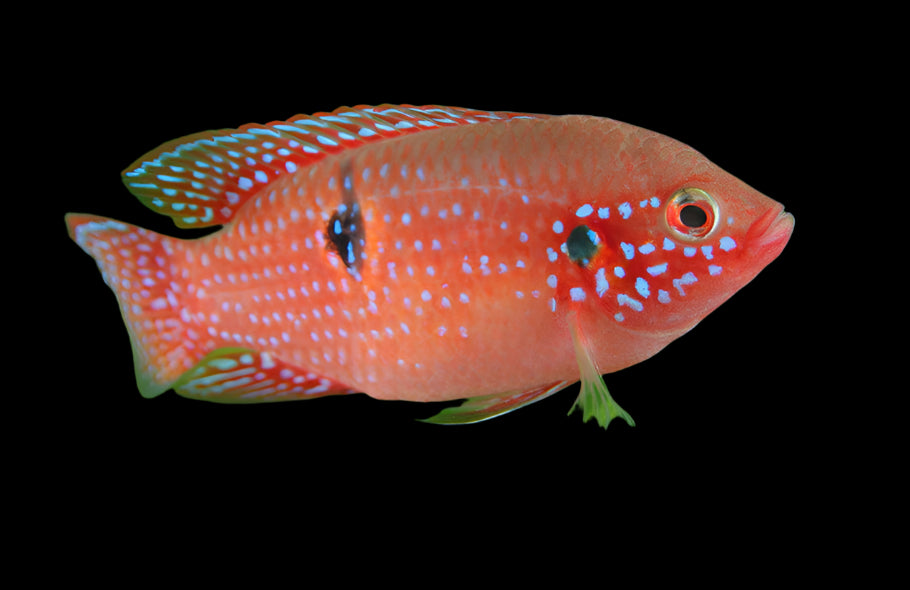Description
Jewel Cichlid – A Sparkling Gem with Fiery Personality
The Jewel Cichlid (Hemichromis spp.) is a true standout in any freshwater aquarium, known for its dazzling, jewel-like coloration. These vibrant fish feature intense red, orange, or blue hues adorned with iridescent spots that shimmer under aquarium lighting—earning them their gemstone-inspired name.
Native to rivers and streams of West and Central Africa, Jewel Cichlids are hardy and adaptable but also known for their territorial and sometimes aggressive behavior, especially during breeding. They thrive in tanks with ample hiding spots, stable water conditions, and room to establish territory.
Key Features:
-
Coloration: Bright red to reddish-orange body with sparkling blue or turquoise spots
-
Temperament: Aggressive, especially during spawning—best suited for species-only tanks or experienced aquarists
-
Size: Grows up to 6 inches
-
Tank Requirements: Minimum 30 gallons with rocks, caves, and plants for cover
-
Diet: Omnivorous—enjoys pellets, flakes, frozen/live foods, and occasional veggies
-
Compatibility: Best kept with other robust cichlids or in species-specific setups
The Jewel Cichlid offers a perfect combination of brilliant color and lively behavior, making it a rewarding choice for cichlid lovers who appreciate both beauty and boldness in their aquarium.
Click & Collect
Livestock will only be bagged once you arrive, or if you contact us in advance to request it ready beforehand.
Local Delivery
Order anything from our in-store range and have it delivered right to you.
-
Minimum spend: £50
-
Delivery up to 10 miles: £10
-
Delivery up to 25 miles: £20
Distances are measured “as the crow flies”, not by road.
Once your order is placed, we’ll be in touch to arrange a suitable delivery date and time.
Please note, delivery may take a little longer as we often group orders together to build an efficient delivery run.
Important: If you’re ordering a large aquarium, please ensure someone is available to help unload the van on arrival.
Dry Goods Delivery
-
DX Express: 1 working day, same-day dispatch before noon 0-75kg
-
Express Pallet: 1–3 working days 75-500kg
If you'd like to add more items to an existing order that hasn't yet been dispatched, please place a Click & Collect order and leave a note asking us to combine the orders.
Please note: We currently only dispatch parcels Wednesday to Friday.
Pre-Order
Want the full details? Check out our Terms & Conditions.
Livestock Delivery
Thursday Delivery – £24
-
Dispatched Wednesday afternoon
-
Delivered Thursday before 1pm
-
Order by Wednesday 12 noon
-
Minimum spend: £50
Friday Delivery – £24
-
Dispatched Thursday afternoon
-
Delivered Friday before 1pm
-
Order by Thursday 12 noon
-
Minimum spend: £50
Saturday Delivery – £29
-
Dispatched Friday afternoon
-
Delivered Saturday before 1pm
-
Order by Friday 12 noon
-
Minimum spend: £50
📦 Want to Add to an Existing Order?
No problem! Just place a Click & Collect order and leave a note asking us to link it with your original one (as long as it hasn’t been dispatched yet).
🛒 Dry Goods Now Included!
You can now include dry goods in your livestock delivery – perfect for topping up supplies in one go.
❄️ Please note: We can’t send frozen food with livestock – please order frozen items separately.
⚠️ Delivery Exclusions
Unfortunately, we’re unable to deliver livestock to the following postcodes:
Scotland & Isles:
AB30–AB56, DD8–DD10, DG3–DG9, DG12–DG14, FK17–FK21, KA18–KA19, KA26–KA30, PA20–PA38, PA80, PH3–PH40
Cornwall Isles: TR21–TR25
All of the following postcodes are excluded:
BT, HS, IM, IV, JE, KW
Plus Channel Islands and Shetland Islands
Payment & Security
Your payment information is processed securely. We do not store credit card details nor have access to your credit card information.

